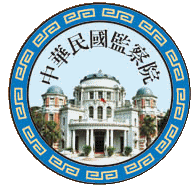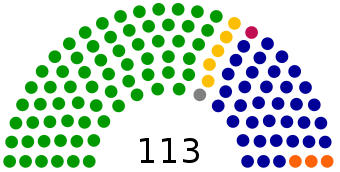Control Yuan
 Logo | |
|
| |
| Agency overview | |
|---|---|
| Formed | February 1931 |
| Jurisdiction |
|
| Headquarters | Zhongzheng, Taipei, Taiwan |
| Agency executives |
|
| Website | www.cy.gov.tw |
| Control Yuan | |||||||||||||||||||||||||||
| Chinese | 監察院 | ||||||||||||||||||||||||||
|---|---|---|---|---|---|---|---|---|---|---|---|---|---|---|---|---|---|---|---|---|---|---|---|---|---|---|---|
| |||||||||||||||||||||||||||
The Control Yuan (CY; Chinese: 監察院; pinyin: Jiānchá Yuàn; Wade–Giles: Chien1-ch'a2 Yüan4), one of the five branches of the Government of the Republic of China (Taiwan/ROC), is an investigatory agency that monitors the other branches of government. It may be compared to the Court of Auditors of the European Union, the Government Accountability Office of the United States, a political ombudsman, or a standing commission for administrative inquiry.
History
Control Yuan was established in February 1931 succeeding the role of Auditing Yuan (Chinese: 審計院). Auditing Yuan was subsequently downgraded to a ministry and incorporated into the Control Yuan.[1]
Powers and responsibilities
- impeachment
- censure
- supervision
- audit
- investigation of officials
- receipt of petition complaints concerning officials
- supervising of Examination Yuan exams for prospective government workers
- Implementation of the freedom of information legislation (through Taiwan's Sunshine Acts) for financial transactions and gifts involving politicians
- suggestion of corrective measures to correct issues of neglect or malfunction in the Executive Yuan
- human rights protection
- international collaboration with ombudsman and human rights institutions, including the International Ombudsman Institute
Structure

The structure of the Control Yuan consists of the President, Vice President, a 27-member council and the Ministry of Audit (also known as the National Audit Office).
Council
The council of the Yuan, chaired by the Yuan President, is divided into a number of committees to fulfill the Yuan's various purposes.
Committees
The seven standing committees cover the following:
- domestic and ethnic minority affairs
- foreign and overseas Chinese affairs
- national defense and intelligence affairs
- finance and economic affairs
- education and cultural affairs
- transportation, communications and procurement affairs
- judicial affairs and prison administration
In addition, Control Yuan members join five special committees:
- Committee on Statutory Studies
- Committee on Consultation
- Committee on Discipline for Control Yuan Members
- Committee on Anti-Corruption
- Committee on Human Rights Protection
An Administrative Appeal Committee, operated under the aegis of the Control Yuan but consisting of both members and non-members of the Control Yuan, considers administrative appeals which are inappropriate to both the Control Yuan proper and the Ministry of Audit.
Finally, two organizational affairs committees:
- Budgetary Planning and Administrative Committee - which provides suggestions on the planning and drawing up of the Control Yuan’s annual budget
- International Affairs Committee - which provides for collaboration and communication with the audit and ombudsman institutions of other governments.
No member of the Control Yuan can hold another public office or profession while serving in the branch (according to Article 103 of the constitution), and members must be able to perform absent of partisan control or influence. Members can vote in no more than three committees and can join additional committees as non-voting members. Each committee can have up to 14 members and usually elects a convenor amongst themselves to chair committee meetings.
Ministry of Audit
The Ministry of Audit, also known as the National Audit Office and headed by an auditor-general who is nominated by the President of the Republic and appointed with consent of Parliament, exercises the Control Yuan's power of audit. It consists of five departments:
- general public affairs audit department
- national defense expenditures audit department
- special public affairs audit department
- state-run corporations and government-owned businesses audit department
- financial affairs audit department (also in charge of supervising local government audits)
Subordinate agencies are largely local extensions of the Ministry:
- Taipei Municipality Audit Division
- New Taipei Municipality Audit Division
- Taichung Municipality Audit Division
- Tainan Municipality Audit Division
- Kaohsiung Municipality Audit Division
- Audit Offices of Various Counties and Cities
History
Pre-republican China
The idea for the Control Yuan was inspired by a long tradition of supervision used in past dynasties, ranging from the Censor (御史; yù shǐ) established by the Qin(秦) and Han(漢) dynasties to the tái (臺) and jiàn (諫) offices established under the Sui(隋) and Tang(唐) dynasties (tai were selected to supervise civil officials and military officers, while jian were selected to counsel the emperor on supervisory matters) to the Board of Public Censors (都察院; dūchá-yuàn) selected under the Ming(明) and Qing(清) dynasties. Most of these offices also operated local and provincial branches to supervise local governments.
Under the Qing dynasty, the Board of Public Censors consisted of forty or fifty members, and two presidents, one of Manchu ancestry and the other of Chinese ancestry.[2][3] They were, in theory, allowed to send one censor to participate in the meetings of all government boards. The Board's powers were minimized by the time of political flux which preceded the end of the Empire.
Republican China
As a republican phenomenon, the idea of government supervision and audit was adopted by Sun Yat-sen during his involvement with the Tongmenghui as part of five proposed branches of republican government. Following the establishment of the provisional republican government, the traditional three branches were initially put in place. By 1928, however, the Control and Examination Yuans were established by the provisional government. A sixth Auditing Yuan (審計院; pinyin: Shěnjì Yuàn) was established in February 1928, but in February 1931, the Auditing Yuan was downgraded to the current Ministry of Audit and incorporated into the Control Yuan.
The first formal Control Yuan was elected by provincial, municipal, Mongolian, Tibetan, and Overseas Chinese representative councils and was first convened in 1948 following the enactment of the 1947 Constitution. Most branch offices of the Control Yuan were closed following the KMT evacuation to Taiwan from the mainland.
In Taiwan
In 1992, the selection process for the Control Yuan was reformed by constitutional amendment, with representative council elections being replaced by National Assembly confirmations. This was further reformed in 2000 by the replacement of the National Assembly with the Legislative Yuan for confirmation elections.
At the end of 2004 President Chen Shui-bian sent a list of nominees to positions in the Control Yuan to the Legislative Yuan for approval. The Pan-Blue Coalition, which then held a majority in the Legislative Yuan, refused to ratify President Chen's nominees and demanded that he submit a new list. The political deadlock that resulted stopped the Control Yuan from functioning from February 2005 to July 2008. Following the election of President Ma of the Pan-Blue Coalition, the Legislative Yuan ratified a new list of members of the Control Yuan and Wang Chien-shien was appointed to be its President.
List of Presidents of the Control Yuan

Pre-1947 Constitution Ratification
- Cai Yuanpei (8 October 1928 - 29 August 1929) not inauguration
- Zhao Daiwen (趙戴文) (29 August 1929 - 18 November 1930) not inauguration
- Yu Youren (18 November 1930 - 9 June 1948)
Post-1947 Constitution Ratification
- Yu Youren (9 June 1948 - 10 November 1964)
- Li Shih-tsung (李嗣璁) (10 November 1964 - 17 August 1965) acting
- Li Shih-tsung (李嗣璁) (17 August 1965 - 15 May 1972)
- Chang Wei-han (張維翰) (15 May 1972 - 19 March 1973) acting
- Yu Chun-hsien (余俊賢) (19 March 1973 - 12 March 1987)
- Huang Tzuen-chiou (黃尊秋) (12 March 1987 - 1 February 1993)
- Chen Li-an (1 February 1993 - 23 September 1995)
- Cheng Sui-je (鄭水枝) (23 September 1995 - 1 September 1996) acting
- Wang Tso-yung (王作榮) (1 September 1996 - 1 February 1999)
- Fredrick Chien Foo (1 February 1999 - 1 February 2005)
- Post vacant (1 February 2005 - 1 August 2008)
- Wang Chien-shien (1 August 2008 - 31 July 2014)
- Chang Po-ya (31 July 2014 - present)
See also
| Wikimedia Commons has media related to Control Yuan. |
- Government of the Republic of China
- Politics of the Republic of China
- State Comptroller of Israel (A Similar office of a Government Monitor)
- Censorate
References
- ↑ http://www.cy.gov.tw/ct.asp?xItem=6036&CtNode=989&mp=21
- ↑ Hawke's Bay Herald. Volume XXXV, Issue 11595. Monday, July 23, 1900. Page 2.
- ↑ The Statesman's year-book, Volume 47. Page 685.
External links
| This article is part of a series on the |
| Politics of the Republic of China |
|---|
 |
| Commonly known as Taiwan |
|
Leadership |
|
|
|
Other branches 
|
|
Related topics |
|
Taiwan portal |
Coordinates: 25°02′43″N 121°31′12″E / 25.04528°N 121.52000°E

